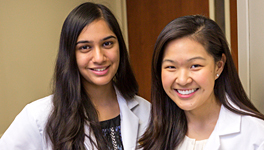Learn more about the duties, practice settings, typical workdays, and educational opportunities, as well as personal advice from pharmacists in this practice area.
What is emergency medicine pharmacy?
Emergency Medicine (EM) Pharmacy is a pharmacy practice area in which pharmacists work alongside the medical team to care for patients presenting to the emergency department. This entails quickly assessing the undifferentiated patient and treating a wide range of disease states and acuity levels. In addition to extensive critical care training, EM pharmacists typically have expanded knowledge of pre‐hospital medicine, emergency preparedness, and toxicology.
Some of the disease states that an EM pharmacist could see include acute coronary syndrome, heart failure exacerbations, cardiac arrests, trauma/burn, stroke, infections like pneumonia, urinary tract infections (UTIs), skin and soft tissue infections (SSTIs), gastrointestinal infections, sepsis/septic shock, toxicology, status epilepticus, status asthmaticus, COPD exacerbations, diabetic ketoacidosis, thyroid storm, and many others.
Where does an emergency medicine pharmacist work?
An EM pharmacist works in the emergency department. This field has progressed as a profession, so most EM pharmacists sit amongst the providers to allow for collaborative patient assessment and treatment discussions.
Some EDs have pharmacy satellites with IV hoods that pharmacists, pharmacy technicians, and interns can compound and dispense medications from. Other EDs may have only one pharmacist throughout the day, while others may have 24-hour coverage. Direct patient care is provided at the bedside. This includes activities like interviewing patients, recommending and compounding infusions for the nurse during a resuscitation, monitoring and adapting treatment as the patient responds (or does not respond), and counseling patients who are being discharged. Practice can vary, so the pharmacist’s role varies from institution to institution.
What does a typical workday look like?
For an emergency medicine pharmacist, a typical day begins with patient care rounds, which are truncated compared to inpatient rounding and focus on active issues and dispositions. Unlike other areas of the hospital, there are not traditional “rounds” because patients present to the ED throughout the day. As a result, EM pharmacists generally have to stay in or near the ED throughout the day because a trauma, stroke, or critical patient may present to the ED at any time.
Daily tasks may look very different at each institution based on order verification, patient profile review, documentation, and medication preparation expectations. Most of the day is spent performing bedside patient assessment and discussing treatment plans with the medical team. However, there are also order verification responsibilities and medication preparation at the bedside in urgent and emergent situations. EM pharmacists are also involved with pharmacy and hospital committees, preceptor duties, research, medication safety, and other involvements on top of patient care responsibilities.
What educational opportunities are available for pharmacists in this area?
- EM is now recognized as a pharmacy specialty, so an emergency medicine board certification examination will be available. To find out more about board certification, you can visit the Board of Pharmacy Specialties Board Certification webpage.
- ASHP has an Emergency Medicine Certificate program that covers the core EM topics with a series of recorded lectures and quizzes from EM pharmacists around the country.
- Basic life support, advanced cardiovascular life support, pediatric advanced life support, and emergency neurological life support certifications are a few to look at as you start to assess your current skill set.
How can I learn more about this career path?
- ASHP has an Emergency Medicine Connect website where individuals can ask the EM community questions about the profession.
- At the ASHP Midyear Clinical Meeting (MCM) there is an EM networking session to discuss clinical topics, review EM-specific research posters, and chat with other EM pharmacists across the country. There is an EM social at the ASHP Midyear Clinical Meeting where you can socialize in a casual environment with EM pharmacists.
- The ASHP Emergency Medicine Section Advisory Group also has a website that houses a recorded pharmacist series (REPS) composed of short recorded lectures on key EM topics that are updated regularly.
- Asking faculty at your school/college to help you identify practitioners who could serve as a preceptor and/or mentor is a great place to start. Work with your experiential education coordinator to ensure that you have exposure to critical care in your APPE schedule. Hands-on experience will definitely help you figure out if this is the path for you.
- Shadowing is also an option during off-months, as well as summer internships. ASHP has many resources available to assist in residency application preparation, and students can also engage in their SSHP to further explore career options.
- Additionally, you can learn more about EM on Twitter by following @ASHP_EMPharm.
Member Career Profiles
Jenny Koehl, PharmD, BCPS
Emergency Medicine Clinical Pharmacist
Massachusetts General Hospital
What interested you in pharmacy and this career path?
“Research was really the avenue to both pharmacy and EM. During my undergraduate training I was on a research team exploring the killing mechanism of a natural clay found in Jordan that killed the most drug resistant organisms. My excitement in this drug research and discovery brought me to pharmacy school. Following my second year of pharmacy school I traveled to Tanzania, Africa, for the summer to work on a research project assessing the safety of procedural sedation in the emergency department of their national hospital. There I fell in love with the pace of the emergency department, the energy of the people, the rapid decision-making, and the speed at which the drugs took effect. Honestly, I never looked back.”
What advice do you have for someone interested in this career field?
“Seek out opportunities to be involved and learn more about the field early on whether that be through researching, shadowing, or taking an EM rotation. Also, find a supportive mentor and/or network with others in the EM community to help you navigate your training and future career path.”
David E. Zimmerman, Pharm.D., BCPS, BCCCP
Associate Professor of Pharmacy at Duquesne University School of Pharmacy
Emergency Medicine Clinical Pharmacist at University of Pittsburgh Medical Center-Mercy Hospital
@DEZ_EM_Pharm
What interested you in pharmacy and this career path?
“I did not have a chance to complete an EM APPE rotation; however, during my PGY1 year I had an EM rotation early on that solidified my love for EM. I was simply amazed at the impact my preceptors had on patient care and how much the ED team depended on them. I saw the importance of the healthcare team building a differential diagnosis and my role in thinking ahead on the pharmacologic and non-pharmacologic treatment for that patient and each of the different diagnoses. This is not to say that we as pharmacists do not have roles in the evaluation and diagnosis stage. I have lost track of how many medication-related ED visits that I have identified in my career. Another one of my passions is toxicology - one where I can have a huge role in the ED with recognizing various toxidromes early on, identifying the potential agents, and then treating the patient.”
What advice do you have for someone interested in this career field?
“Learn more about it! Check out the links and resources above. Ask to shadow an EM pharmacist or connect via Twitter or ASHP Connect to learn more.”
Member Spotlight
Heather Eppert
Credentials: Pharm.D., BCPS
Position/Title: Clinical Specialist, Emergency Medicine and Assistant Professor, Department of Clinical Pharmacy
Organization: Blount Memorial Hospital and University of Tennessee College of Pharmacy
Primary Specialty: Emergency Medicine
Specialties: Emergency Cardiovascular Care, Advanced Cardiac Life Support
Daniel Hays
Credentials: PharmD
Position/Title: Clinical Pharmacist
Organization: University Medical Center/University of Arizona
Primary Specialty: Emergency Medicine
Kyle Weant
Credentials: Pharm.D., BCPS
Position/Title: Clinical Specialist-Emergency Medicine/Critical Care
Organization: University of Kentucky HealthCare
Primary Specialty: Emergency Medicine
Specialties: Critical Care


